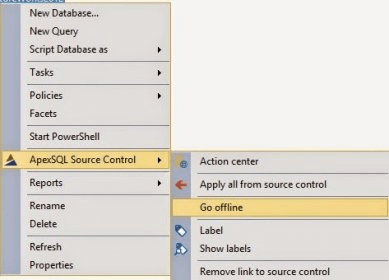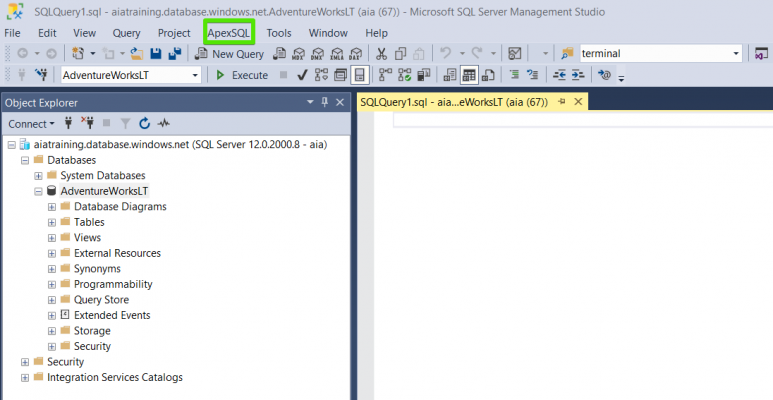

- #Apex sql download from source control how to#
- #Apex sql download from source control full#
- #Apex sql download from source control software#
In contrast, while SSDT does include some filtering functionality in Visual Studio’s schema compare tool, it’s not as easy to source control your filters and to use them when publishing DACPACs to production environments. You can even use them to do quite complicated stuff to manage multiple databases with several known variations, but I’d generally discourage going down that road if you can. Whether you want to filter out something small (like the IsSqlCloneDatabase extended property added by SQL Clone) or whether you want to set up your own naming conventions, these things work a treat. This is a big win for Redgate – SQL Source Control filters are, frankly, awesome. Or perhaps you want to filter out some other objects that are supposed to exist in your dev environment, but not production, such as the tSQLt unit testing framework? Perhaps you aren’t interested in versioning objects prefixed with “test_”. In fairness, Redgate have recently released their own pre- and post-deploy script feature, so they aren’t far behind – but the Redgate scripts do not support SQLCMD variable syntax like the SSDT version does and they do not have anything like the refactor log.

SSDT pre- and post-deploy scripts are a pain to maintain, but ultimately, they work more reliably. In contrast SSDT gives you both pre- and post-deploy scripts and the refactor log. Redgate’s “ migration scripts” feature is hard to understand and has a tendency to break in nasty ways and cripple your performance. For example:īoth SSDT and Redgate SQL Source Control have features to help you in these scenarios, but the SSDT features are better.
#Apex sql download from source control software#
When deployments scripts are generated by schema comparison tools, which do not look at or understand your data, there are some scenarios which can cause the software problems.

On balance, SQL Source Control is much easier and more natural tool for most database folks. The SSDT table designer is amazing, combining the SSMS table designer and a query window and allowing you to use whichever you prefer. This makes the learning curve much more difficult for people who are used to working in SSMS.
#Apex sql download from source control full#
If your developers and DBAs prefer to work in SSMS, SQL Source Control may feel very natural to them, but Visual Studio is full of new concepts: Solutions files? Project files? MSBuild? The list goes on. Redgate SQL Source Control plugs right into SQL Server Management Studio (SSMS), whereas SSDT lives in Visual Studio (VS).

Choosing a tool that is easy to adopt will make your life much easier and lead to a far greater chance of success. Implementing database source control or continuous integration is a big change for your team and it will be hard on your developers and you will move more slowly to begin with. Other model-based tools certainly exist (see ApexSQL source control, DBmaestro and dbForge Source Control for example) but none are anywhere near as widely used or trusted for SQL Server databases as either SSDT or Redgate SQL Source Control. SSDT and SQL Source Control are the two most widely used tools in Europe and North America for model-based source control and deployment of SQL Server databases. I believe it’s important to use widely used and supported tools wherever possible. So what about alternative model-based solutions? To avoid getting tangled up in higher level debates about whether to adopt a migrations-based or a model-based source control solution – or even a hybrid, this blog post is specifically scoped to model-based source control solutions. I’ve written about the relative pros and cons here but the tl dr is that neither are perfect, both hold value, and generally you do need to pick one or the other. I hope this post will help you to decide which is more likely to suit you and your team.īut first… Why SSDT or SQL Source Control and not something else?įirstly, there are two styles of database source control and deployment: Model (aka “state”) and Migrations. Now, dear reader, I’m going to review and compare the two most popular tools to help you put it all together: Microsoft SSDT/Visual Studio Database Projects and Redgate SQL Source Control.
#Apex sql download from source control how to#
Last year I delivered a session on GroupBy all about how to do Database DevOps right, and back in May I wrote a blog post for BOU about how to screw it up. My name’s Alex, and I care about databases, DevOps and data protection.


 0 kommentar(er)
0 kommentar(er)
